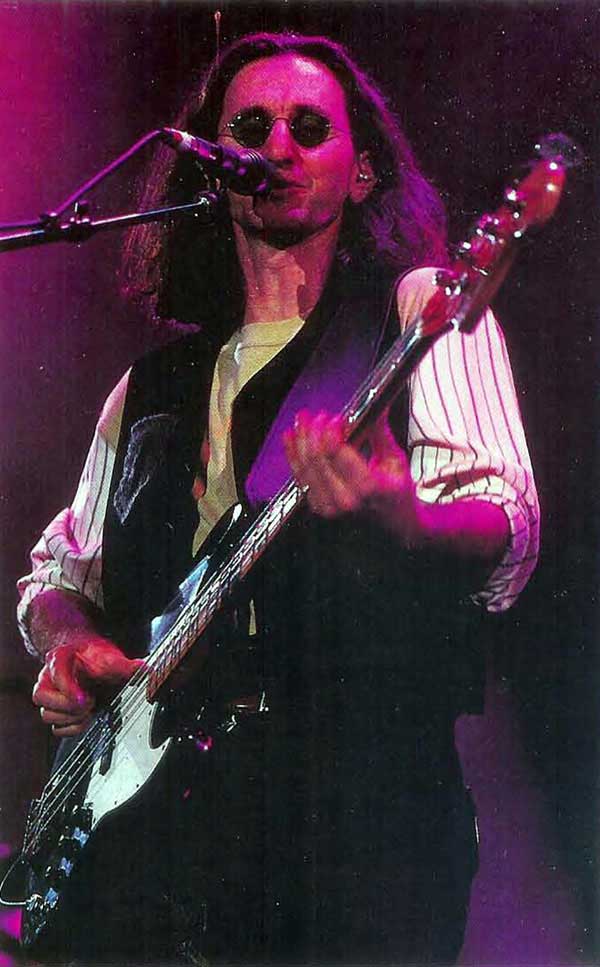On The Spot: Geddy Lee of Rush
By Pete Brown, Guitar Shop, December 1996, transcribed by pwrwindows

Bassist Geddy Lee has often described Rush, the Canadian power trio he's led for more than 23 years, as "the world's biggest cult band." Maybe so, but this "cult band" has gone gold or platinum with every album they've ever released, a streak that's sure to continue with their sixteenth studio effort, Test For Echo. Echo, Rush's roughest tumble since 1981's Moving Pictures, is anchored by Alex Lifeson's rugged Les Paul Custom and Ged's thunderous Fender Jazz Bass. Ged graciously received Guitar Shop in his hotel room at New York's posh Four Seasons, where celebrity sightings of the day included Sly Stallone, Whoopi Goldberg, and members of AC/DC. Here's the skinny on Echo's tough tones.
Before going back to your '72 Fender Jazz on 1993's Counterparts, you'd been using Wals for a number of years. What do you feel are the differences between the two?
The Wal has a bit more finesse in its sound. It has a snappier top end, but it's not quite as aggressive in the midrange. It also doesn't have the same bottom-end response that the Fender has. The Fender has a warmer, slightly more crude bottom end, and that's what I was after for Echo. In general, I would say that the Wal has a more refined sound. I still play them; they're really fantastic, and the necks arc just beautiful. I actually feel I play better on the Wal, because the neck agrees with me. It's a faster neck than the Fender. But the sound I'm after right now is the Fender sound.

On Test for Echo, the low end sure is good and meaty.
There's a lot of bottom end there [laughs]! In some ways, it was a big experiment to capture the Fender sound in such an aggressive, confident way. I just wanted to have a lot of subsonics going, so for a lot of the songs - like "Virtuality," "Color of Right," and "Dog Years" - I used a detuned E string.
How about amplification?
I didn't use any live amps this time. I used a combination of DI's and speaker simulators: a Demeter tube direct, a Palmer speaker simulator, and a SansAmp. During the early stages of bed tracks, we fiddled around with various pieces of equipment, but this setup worked best. I'd never done it this way before, but I think the combination of those three things created enough of an amp sound that I found it very satisfying. I've never had that experience in the past. Usually I've felt like there was something missing.
So what amp gear will you take out on the road?
I'll still use my Trace Elliot Quatra 4VR amps and the Trace Elliot GP12SMX preamp, and I'd like to take the SansAmp/Palmer combination, too, because I think it'll work better with the venues' PA systems. I'm going to experiment with that in rehearsals.
Tell us about your first ever bass-a Conora, wasn't it?
Right. I bought it from the local music shop for like 35 bucks, when I was about 14 or 15. My mother loaned me the money. I wanted a bass, and that one looked good [laughs]. And then I had a Hagstrom, which I used right up through the early incarnations of Rush, when I got a '69 Fender Precision. And once we'd gotten our first record deal, I had enough money to buy a Rickenbacker 4001, which I'd always wanted because of watching Chris Squire and Paul McCartney. I liked the fact that the Ricky had a separate control for the treble pickup and for the bass pickup. I used those for years until I started playing a Steinberger, which was for a strange reason: It was physically easier for me to get in and around my keyboards using the smaller bass. It was lighter, it didn't whack into my other mics, and it was ergonomically easier to get around my gear during that heavy keyboard period. But the sound just wasn't good enough; it was too limiting. It's a great practice bass, though, because it 's so portable. Whenever I travel. I usually take it with me. And then I went to the Wals for a few years; our producer, Peter Collins, had introduced me to them, and I'd used one of his on [1985's] Power Windows. I'd heard of them before; Percy Jones from Brand X had used one, and I loved that sound. That's when I also started using lighter-gauge strings, which gave a little more snap to my top end. So I used those until Counterparts; then I went back to the Fender Jazz, which I'd also used on at least half of Moving Pictures. Like on "Tom Sawyer" - a lot of people think that's the Ricky, but it's the Jazz.
Didn't you cut the '69 Precision into the shape of a star or something?
A teardrop, actually. It was very trendy for a while for Toronto bass players to have teardrop-shaped Precisions, It 's got a monster sound, but it's totally uncontrollable. I put a set of Jazz pickups on it, and it's wild; it's the loudest bass you'll ever hear - totally in your face. But I ruined it by cutting the horns off and painting it like a '57 Chevy in a fit of mental retardation! I hate when that happens: "Wouldn't it be cool if I did this?" Yeah, for about 5 minutes... I pulled it out the other day, and it looks so awful. It's baby blue and white-just a gross thing.